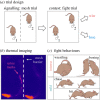Scent mark signal investment predicts fight dynamics in house mice
- PMID: 36787797
- PMCID: PMC9928526
- DOI: 10.1098/rspb.2022.2489
Scent mark signal investment predicts fight dynamics in house mice
Abstract
Signals mediate competitive interactions by allowing rival assessment, yet are often energetically expensive to produce. One of the key mechanisms maintaining signal reliability is social costs. While the social costs of over-signalling are well known, the social costs of under-signalling are underexplored, particularly for dynamic signals. In this study, we investigate a dynamic and olfactory-mediated signalling system that is ubiquitous among mammals: scent marking. Male house mice territorially scent mark their environment with metabolically costly urine marks. Competitive male mice are thought to deposit abundant scent marks in the environment. However, we recently identified a cohort of low-marking males that win fights. We hypothesized that there may be social costs imposed on individuals who under-invest in signalling. Here we find that scent mark investment predicts fight dynamics. Winning males that produce fewer scent marks prior to a fight engage in more intense fights that take longer to resolve. This effect appears to be driven by an unwillingness among losers to acquiesce to weakly signalling winners. We, therefore, find evidence for rival assessment of scent marks as well as social costs to under-signalling. This supports existing hypotheses for the importance of social punishment in maintaining optimal signalling equilibria. Our results further highlight the possibility of diverse signalling strategies in house mice.
Keywords: house mice; scent marking; signal investment; social costs; strategy.
Conflict of interest statement
We declare we have no competing interests.
Figures




References
-
- Enquist M. 1985. Communication during aggressive interactions with particular reference to variation in choice of behaviour. Anim. Behav. 33, 1152-1161. (10.1016/S0003-3472(85)80175-5) - DOI
-
- Wagner WE. 1989. Fighting, assessment, and frequency alteration in Blanchard's cricket frog. Behav. Ecol. Sociobiol. 25, 429-436. (10.1007/BF00300189) - DOI
-
- Johnstone RA, Norris K. 1993. Badges of status and the cost of aggression. Behav. Ecol. Sociobiol. 32, 127-134. (10.1007/BF00164045) - DOI
Publication types
MeSH terms
Substances
Associated data
LinkOut - more resources
Full Text Sources
Miscellaneous

